Did Biden Get China Right?
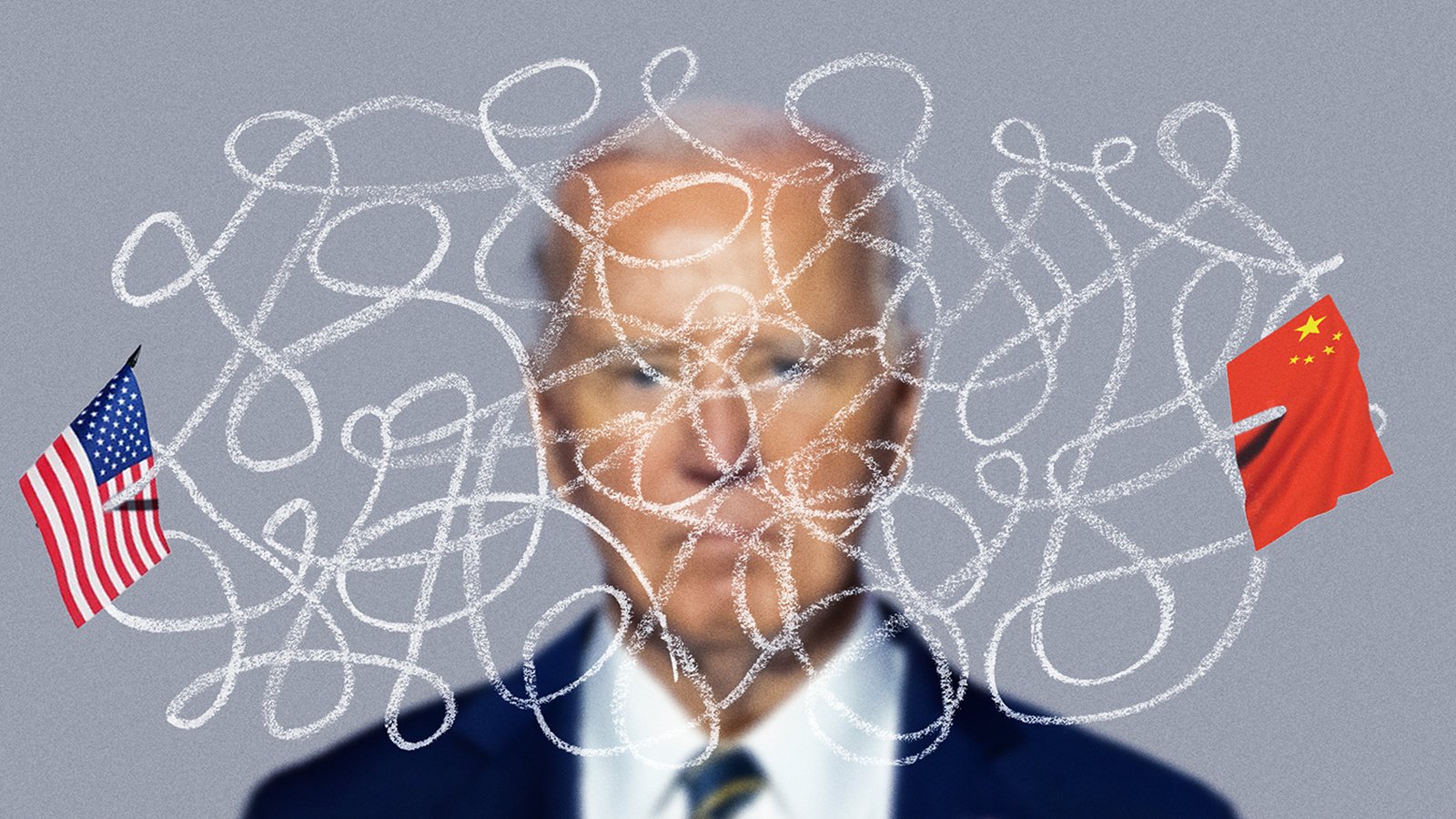
Deep Dive
Did Biden Get China Right?
The administration aimed to outcompete China. Four years later, here’s how it measured up.
Nicolás Ortega illustration for Foreign Policy
Two months into Joe Biden’s presidency, top officials from the United States and China descended on Anchorage, Alaska, a midpoint between their capitals. The meeting site, Hotel Captain Cook, paid homage to the 18th-century British explorer who laid the groundwork for Western imperialism in the Pacific—an era whose ongoing legacy Chinese officials had come ready to contest.
In their opening remarks for the two-day summit, Secretary of State Antony Blinken and National Security Advisor Jake Sullivan laid out a litany of concerns about China’s behavior, from Xinjiang, where China was committing human rights abuses, to the Taiwan Strait, where China was increasingly asserting its military strength. “Each of these actions threaten the rules-based order that maintains global stability,” Blinken said to his Chinese counterparts, who were lined up for the face-off at a separate table across the room. The U.S.-China relationship “will be competitive where it should be, collaborative where it can be, adversarial where it must be,” he continued.
Two months into Joe Biden’s presidency, top officials from the United States and China descended on Anchorage, Alaska, a midpoint between their capitals. The meeting site, Hotel Captain Cook, paid homage to the 18th-century British explorer who laid the groundwork for Western imperialism in the Pacific—an era whose ongoing legacy Chinese officials had come ready to contest.
In their opening remarks for the two-day summit, Secretary of State Antony Blinken and National Security Advisor Jake Sullivan laid out a litany of concerns about China’s behavior, from Xinjiang, where China was committing human rights abuses, to the Taiwan Strait, where China was increasingly asserting its military strength. “Each of these actions threaten the rules-based order that maintains global stability,” Blinken said to his Chinese counterparts, who were lined up for the face-off at a separate table across the room. The U.S.-China relationship “will be competitive where it should be, collaborative where it can be, adversarial where it must be,” he continued.
The U.S. officials’ speeches made it clear that after the tumultuous last year of the Trump administration, when U.S.-China relations hit a new low point, there would be no great reset.
The Chinese officials listened impassively behind their COVID-19 masks. Then, in a professorial tone, Yang Jiechi, China’s senior diplomat at the time, launched into a now famous diatribe against the United States. China, he said, followed international law rather than the rules-based order defined by the United States and followed by a “small number of countries.” Continuing well past his two-minute slot, Yang said, “The United States itself does not represent international public opinion, and neither does the Western world.”
After a rebuttal from the U.S. side, Yang concluded his remarks with a forceful dismissal that would echo across the Chinese internet: “The United States does not have the qualification to say that it wants to speak to China from a position of strength.”
Yang Jiechi (center) leads the Chinese delegation in talks with their U.S. counterparts in Anchorage, Alaska, on March 18, 2021. Frederic J. Brown/AFP via Getty Images
Rush Doshi, director for China and Taiwan at the U.S. National Security Council (NSC) at the time, absorbed Yang’s dressing-down in real time as one of the only Mandarin speakers on the U.S. team. The Chinese officials’ remarks were “highly unusual,” he told Foreign Policy. “It may have been unprecedented.”
“I think it did fundamentally ratify that this was a new era in U.S.-China relations,” Doshi added.
A year after the Anchorage clash, the Biden administration solidified its stance toward China in a series of policy documents: an internal China strategy as well as public strategies for the Indo-Pacific and national security. In the documents, Biden’s team arrived at roughly the same conclusion that former President Donald Trump’s team had: China “seeks to become the world’s most influential power,” and its actions threaten core U.S. interests.
Instead of reverting to the pre-Trump era of engagement, the Biden administration would make outcompeting the ascendant superpower its core priority. The strategy, boiled down to a bumper sticker, was “invest, align, compete”: invest in the domestic economy and democracy, align with allies and partners, and—from that foundation—compete.
In the White House’s view, this would be the “decisive decade” in that competition. “We stand now at the inflection point,” the National Security Strategy released in 2022 stated, “where the choices we make and the priorities we pursue today will set us on a course that determines our competitive position long into the future.”
Three years later, as Biden entered his final weeks in office, the administration declared itself triumphant.
“Our view is that across essentially every area of this competition, the United States is in a stronger position today than we were four years ago,” a senior administration official said, speaking on the condition of anonymity because they were not authorized to talk on the record. And even then, in mid-January of this year, the Biden team wasn’t done. The competition was waged down to the wire, with U.S. agencies unleashing a flurry of significant technology restrictions and sanctions on China in their final days.
With the second Trump administration now reclaiming the baton, FP sought to evaluate the Biden team’s claim of success through a review of the administration’s record and interviews with more than 20 former and current U.S. officials as well as China experts from across the political spectrum.
Those interviewed—a group mostly based in Washington, D.C.—largely agreed that the administration’s focus on strategic competition with China was correct and that Biden’s policies led to some significant gains in that competition. Yet, eight years after the United States initiated the campaign against its rival, debate is building over the strategy’s future. On the right, many China hawks say that Biden simply didn’t go far enough: to outcompete China and avoid conflict, the United States must run faster and hit harder. At the same time, dissenters on the left argue that—in the fog of competition—Washington has lost sight of the urgency of climate change and other long-term U.S. interests. And in that fog, some warn, the two superpowers may be stumbling toward crisis.
Cars drive on a road near Liberty, North Carolina, on Dec. 18, 2024.Cornell Watson for the Washington Post via Getty Images
If you drive across the United States today, the physical landscape has changed since four years ago. Across Texas, Iowa, and Oklahoma, battalions of new wind turbines march across the hills and plains. Cranes loom in the open sky of rural Liberty, North Carolina, where Toyota is building a massive new battery plant. A “tiny Taipei” has sprung up in the desert on the edge of Phoenix, where Taiwanese semiconductor giant TSMC is erecting three “fabs”—factories that will bring cutting-edge chips to the United States.
These new features of the American landscape reflect the first pillar of Washington’s “invest, align, compete” strategy. Democrats hatched an ambitious plan to reindustrialize the country with the goal of preventing China from cornering this century’s leading technologies—and leaving the United States devoid of manufacturing jobs and reliant on Chinese supply chains.
Beginning the competition with China at home followed from the administration’s overarching mission to pursue “a foreign policy for the middle class.” In an early speech delivered at the State Department, Biden described the concept this way: “There’s no longer a bright line between foreign and domestic policy. Every action we take in our conduct abroad, we must take with American working families in mind. Advancing a foreign policy for the middle class demands urgent focus on our domestic economic renewal.”
Trump had also claimed to focus on “domestic economic renewal,” but the Biden team took a different tack. On top of Trump’s favorite tool, tariffs, Democrats took a page from China’s playbook: providing subsidies and incentives to nurture strategic industries. This expanded vision of industrial policy was enacted through a series of sweeping laws that were passed despite narrow margins in the U.S. Senate.
Key among them was the CHIPS and Science Act, which set aside $52 billion to jump-start the United States’ advanced semiconductor manufacturing. These chips are the engine of the modern economy—and of competition with China—powering everything from cars to artificial intelligence. Lawmakers were concerned that one day China could shut that engine off.
That worry stemmed from the Chinese leadership’s long-standing desire for reunification with Taiwan, which it considers a runaway province. The United States purchases 92 percent of its advanced chips from Taiwan, so any blockade or attack there could sever U.S. supply chains. Plus, China is investing billions in growing its own share of global chip production.
With the CHIPS Act, the United States aimed to get in the game. By the time the Biden administration left office last month, the Commerce Department had disbursed roughly $38 billion in grants and loans under the act, with Intel and Samsung as two major beneficiaries alongside TSMC. TSMC’s construction in Arizona is one proof of concept—the first of the chip fabs is expected to begin operations this year, backed by a $6.6 billion award.
Researchers from the Peterson Institute for International Economics wrote in a recent report that “the subsidy package was an essential ingredient for large-scale construction of manufacturing plants on U.S. soil without resorting to high tariffs.”
On clean energy, Democrats also had a Made in America plan: the Inflation Reduction Act (IRA). The idea was to not only reduce emissions but also to wrest the production of green technologies back from China, which had rapidly dominated the field.
That was going to be an uphill battle. When the IRA was passed in August 2022, China already accounted for nearly 80 percent of battery manufacturing capacity, and Chinese companies were producing more than 70 percent of solar panels.
Through tax credits and other incentives, the IRA produced a domestic clean energy boom. In a 2024 report, the Rhodium Group and Massachusetts Institute of Technology found that nearly $90 billion in investments had been driven into green manufacturing since the law’s passage, four times the pre-IRA baseline. As a result, the United States is inching up on bar charts depicting clean energy investment, even as China’s spending continues to grow.
There are qualms on the right about how the money is being spent. Some Republicans have criticized the law for allowing Chinese companies to be eligible for tax credits, which has brought a wave of new Chinese investment into the United States. More fundamentally, the new administration doesn’t see these subsidy programs as critical to the future of U.S. competitiveness in the same way. Trump plans to upend many of the Biden-era subsidies, including for electric vehicles (EVs), which he has dismissed as part of a “green new deal” agenda of climate action.
Of course, billions of dollars in government subsidies for chips or solar panels don’t automatically guarantee competitiveness, as China’s own industrial policies show. But the Biden team, and many outside experts, viewed the passage of these flagship laws as an important opening salvo in the tech war with China.
A collection of photos from U.S. Secretary of State Antony Blinken’s trips to Asian and Pacific outposts. On the top row are India, New Zealand, Japan, and Indonesia. On the bottom row are Vietnam, Thailand, Mongolia, and Laos.Getty Images
Over the last four years, it seemed like hardly a week went by without a senior U.S. official crisscrossing the Indo-Pacific. Last summer alone, Blinken and then-Deputy Secretary of State Kurt Campbell took trips to a dizzying list of countries including India, Japan, Laos, Mongolia, New Zealand, the Philippines, Singapore, Tonga, Vanuatu, and Vietnam.
The Biden administration’s focus on alliances as the second leg of its China strategy came after Trump put the screws on some of the closest U.S. partners during his first term, demanding they pay more for the benefit of American defense. The Biden team set out to reassure and rebuild, not just bilaterally but through a latticework of interconnection in the region surrounding China.
These efforts extended far and wide but frequently involved the United States’ five treaty allies—Australia, Japan, the Philippines, South Korea, and Thailand—in various geometries.
In November 2022, U.S. Vice President Kamala Harris traveled to Palawan, an island in the Philippines facing the South China Sea, where Chinese vessels have been contesting the country’s territorial claims. “We will continue to rally our allies and partners against unlawful and irresponsible behavior,” Harris said, speaking from the deck of a Philippine Coast Guard ship. A year later, Manila returned the show of support, granting Washington access to four additional military bases, including one on Palawan and two in the country’s north, facing Taiwan.
For its East Asian allies, the United States sought a new trilateral arrangement. A historic summit at Camp David in August 2023, where Biden met with South Korean President Yoon Suk-yeol and then-Japanese Prime Minister Fumio Kishida, marked the success of that campaign. The three countries agreed to annual joint military exercises and reaffirmed the importance of “peace and stability across the Indo-Pacific.”
“Deterrence is not just about hard military deterrence, it’s also about China’s perception of a cost internationally to its economy if it did something reckless toward Taiwan,” said Rick Waters, managing director of the Eurasia Group’s China practice and a former top China policy official at the State Department. “And I think that’s an area where the administration made huge progress, particularly after Ukraine,” in getting third countries to talk about the importance of peace in Taiwan, he added. The administration’s progress wasn’t always linear, though. The trilateral grouping’s future was thrown into question in the administration’s final days after Yoon’s impeachment.
Australian Prime Minister Anthony Albanese, Indian Prime Minister Narendra Modi, U.S. President Joe Biden, and Japanese Prime Minister Fumio Kishida post for a photo in Wilmington, Delaware, on Sept. 21, 2024. Brendan Smialowski/AFP via Getty Images
The Quad—a grouping of the United States, India, Japan, and Australia that was formed in 2007—may end up being the most enduring, tied together as it is by common concerns about China. The Biden administration held the first in-person summit of the four nations’ leaders last fall. The day after Trump’s inauguration on Jan. 20, Secretary of State Marco Rubio met with the Quad’s foreign ministers, who were in town for the event, signaling that the group is here to stay even if other alliances are shaken by Trump’s tariff threats.
Experts interviewed by FP pointed to the alliance-building campaign as one of the greatest strengths of the Biden administration’s China policy, but they also identified weak spots. U.S. officials cast a wide net, including establishing three new embassies in the Pacific islands—Tonga, Vanuatu, and the Solomon Islands—where China has made significant inroads in recent years, but the focus remained on core allies, with less success in Southeast Asia, for instance.
“At the end of the day, doesn’t this actually end up looking a lot like where we were four years ago, which is a strong relationship with the Quad and the Quad countries but some degree of weakness elsewhere?” said Zack Cooper, a senior fellow at the American Enterprise Institute. “I don’t think that’s entirely their fault; they couldn’t have known what was going to happen in Seoul the last few months, but I do think it has shifted how their Indo-Pacific strategy will be looked at historically.”
The Biden team did notably extend the focus of alliances beyond defense to securing key supply chains. One example is a State Department program known as the International Technology Security and Innovation (ITSI) Fund, which earmarked $500 million from the CHIPS Act funding to help set up semiconductor manufacturing in U.S. partner countries in Asia and Latin America.
As the CHIPS-goes-global campaign suggests, the ultimate goal—outcompeting China, both technologically and militarily—was never far from mind for Biden’s jet-lagged team.
Nicolás Ortega illustration for Foreign Policy
In any race, there are two basic ways to win: pick up your pace or slow down your opponent.
On the former, the Biden administration combined the billions in investment from the chips and climate legislation with tariffs, maintaining Trump’s sweeping trade war-era policies and adding new ones. Those policies were intended to help U.S. companies reach the leading edge or stay there, insulated from subsidized Chinese competition. But that was only half the strategy.
From the beginning, Biden officials maintained that they did not aim to contain China. “We don’t seek to block China from its role as a major power, nor to stop China—or any other country, for that matter—from growing their economy or advancing the interests of their people,” Blinken said in a May 2022 speech laying out the administration’s China policy.
But in sectors that the Biden team deemed to be of critical strategic value—chips first and foremost—officials were not shy about using all the tools at their disposal to achieve the goal of “maintain[ing] as large of a lead as possible” over China, as Sullivan put it.
The first Trump administration teed up the chip war with China by restricting Huawei’s access to U.S. technology. But midway through Biden’s term, his administration threw down a gauntlet that catapulted the competition to new heights. In October 2022, the Commerce Department announced far-reaching export controls that cut China’s semiconductor industry off from the most advanced chips as well as any U.S. technology needed to manufacture them. The rationale was that the American chips could power China’s AI development, which in turn could supercharge its military.
The announcement had a seismic effect on the Washington-Beijing dynamic, with Jon Bateman of the Carnegie Endowment for International Peace writing that it revealed the Biden administration’s “single-minded focus on thwarting Chinese capabilities at a broad and fundamental level.” Other experts described it as an “act of war.”
From that point on, there was no turning back, and the hits kept coming. The Commerce Department expanded those export controls in 2023 and imposed additional restrictions in 2024, weeks before Trump took office for the second time.
#gallery-2 {
margin: auto;
}
#gallery-2 .gallery-item {
float: left;
margin-top: 10px;
text-align: center;
width: 100%;
}
#gallery-2 img {
border: 2px solid #cfcfcf;
}
#gallery-2 .gallery-caption {
margin-left: 0;
}
/* see gallery_shortcode() in wp-includes/media.php */
- Biden holds a semiconductor chip during his remarks before signing an executive order on the economy in Washington on Feb. 24, 2021. Doug Mills/Getty Images
- New electric cars for sale are seen parked at a distribution center in Chongqing, China, on March 24, 2024. STR/AFP via Getty Images
Chips weren’t the only target. Restrictions on so-called “connected vehicles” from China that included Bluetooth and autonomous driving capabilities were finalized in the waning days of the Biden administration, as were curbs on the export of certain advanced AI models.
Taken together, these moves raised questions about the boundaries of the administration’s “small yard, high fence” approach to keeping U.S. tech from falling into China’s hands. A senior Biden administration official repeatedly described it as a “carefully tailored” approach. “There’s a strong record of actions taken, but those actions have been tailored, focused on the areas of greatest national security concern and focused on taking those steps while minimizing spillover effects that extend beyond the goal of our policy,” they said.
Yet despite the deluge of policies, some experts say that the Biden team didn’t go far or fast enough. “The Trump administration moved a lot quicker; they were more willing to take risks and move faster,” said Liza Tobin, managing director at the geopolitical risk firm Garnaut Global and the NSC’s China director for more than two years across the Trump and Biden administrations. “There is a real element of time here, where China is moving very fast, and the Biden administration’s slow, deliberate policy process was an obstacle to getting more done.”
The jury is still out on how effective the policy has been at slowing China’s AI development. U.S. restraints have inadvertently forced Chinese companies to get creative and accelerate their drive to self-sufficiency—illustrated through milestones such as Huawei’s Mate 60 Pro smartphone, powered by a relatively advanced semiconductor, and China’s DeepSeek AI model, trained on a much smaller number of chips than previously thought possible. Industry experts maintain that the U.S. controls will still hinder Chinese development for some time, but how long is anyone’s guess.
Ryan Hass, director of the Brookings Institution’s China Center and former NSC China director under President Barack Obama, said he supported the Biden administration’s overall approach but added, “If it were up to me, I think that I would probably spend less time trying to slow China down and more time trying to speed America up in this foot race that we’re in—that’s obviously not the balance that they chose.”
As for the clean energy competition, it is still too early to fully judge the effectiveness of the administration’s approach. There are some initial signs of success, however. The investment from the IRA has ensured that, at a minimum, clean energy products will continue to be produced in the United States going forward—and the country is even poised to cut into China’s lead in some sectors. The International Energy Agency projects that U.S. battery manufacturing will triple by 2030, while China’s share of global production is expected to fall from 80 to 60 percent.
But when it comes to driving innovation, in some cases Biden’s strategy may not have been designed to deliver. For instance, with battery and solar panel production, the IRA subsidies are technology agnostic, but some experts have argued that the money should only be going toward next-generation technologies where the United States could still leapfrog China, which has already mastered the lithium-ion battery and conventional solar panel.
On EVs, between the 100 percent tariff on Chinese imports and the “connected cars” rule, the administration effectively put into place a full blockade on Chinese electric cars. Meanwhile, U.S. automakers including General Motors and Ford have walked back their EV production targets, and EVs accounted for just 8 percent of U.S. sales in 2024, compared to 25 percent in China (and nearly 50 percent including hybrids).
Some experts, while acknowledging the national and economic security concerns behind the administration’s policies, have advocated a lighter touch toward Chinese competition in the U.S. auto sector.
“Right now, these new technologies are not price competitive, and they’re not cheap enough for people to actually afford them, so we need to usher on these firms to innovate their way to cheaper products,” said Jonas Nahm, an associate professor at Johns Hopkins University who served on the White House Council of Economic Advisers at the end of Biden’s term.
“It’s important to make the energy transition work … so some competition from China probably would be helpful to create incentives to do that domestically. And, I think, in shutting China out completely, we risk creating this protected market,” Nahm added.
And that protected market poses challenges not just for competitiveness, but also for Biden’s other top priority.
Xi and Biden meet on the sidelines of a G-20 summit in Bali, Indonesia, on Nov. 14, 2022. Saul Loeb/AFP via Getty Images
In the administration’s final days in office, wildfires engulfed Los Angeles, leaving ashes where thousands of homes stood days prior. Researchers found that climate change made the fires both more likely and more intense.
It was a cruel coda to Biden’s presidency, which elevated climate action well beyond any of his predecessors. For the administration, this was not only the decisive decade for competition with China, but also for the climate battle. “Of all of the shared problems we face, climate change is the greatest and potentially existential for all nations,” the Biden National Security Strategy stated.
The document laid out an agenda of simultaneously competing with China and cooperating with it to tackle critical transnational problems, without one yielding to the other. “These shared challenges are not marginal issues that are secondary to geopolitics. They are at the very core of national and international security and must be treated as such. By their very nature, these challenges require governments to cooperate if they are to solve them,” it read.
Yet, in practice, these objectives were in tension with each other.
In the administration’s first year, U.S. officials focused on establishing a strong foundation for the competition, as the meeting in Anchorage made clear. That tone irked the Chinese. When John Kerry, then Biden’s special envoy on climate, visited Tianjin, China, in September 2021, Chinese Foreign Minister Wang Yi warned that climate talks couldn’t be sustained as an “oasis” while the United States took a hostile approach to the bilateral relationship. “If the oasis is surrounded by desert, sooner or later the oasis will also become desert,” he said.
The U.S. side had a different view. “We had an open-door policy on cooperation,” Doshi said. “We made clear to the [Chinese] side, in the very first phone call the president had with [Chinese] President Xi [Jinping], ‘Look, we’re willing to cooperate, but we just don’t want to see it linked to issues in the bilateral relationship, which is what you guys did in the past.’”
These conflicting philosophies came to a head in August 2022, when then-House Speaker Nancy Pelosi landed in Taiwan for a rare high-level visit to the island, which doesn’t have formal relations with the United States. Chinese officials responded with massive military exercises encircling the island and a swift cancellation of talks on military, climate, and fentanyl issues. The desert had indeed swallowed the oasis.
In Bali, Indonesia, that November, Xi and Biden met during a G-20 summit. Both sides, seeking stability after the rocky summer, rebooted cooperation. A few months later, the spy balloon incident, in which a Chinese surveillance craft flew over the United States, raised questions about the extent of Chinese espionage in the country. The resulting uproar blew the two sides off course yet again. But by the end of Biden’s tenure, U.S.-China talks had yielded some tangible results.
For one, the two sides agreed to restart regular communication between their militaries—a return to a critical baseline of stability, especially given that Chinese vessels have nearly collided with U.S. vessels on a number of occasions in recent years.
China also agreed last summer to more tightly control the production of three precursor chemicals that are exported from China to Mexico, where they are then used to produce the fentanyl bound for the United States.
On the climate crisis, the United States and China did not achieve a milestone like they did with the 2014 bilateral agreement that laid the foundation for the 2015 Paris Agreement—that was an anomalous breakthrough that created a new global framework for climate action. But the two countries made progress within that framework. As a result of bilateral diplomacy, China published a national plan to reduce its potent methane emissions, which led to a new regulation to significantly cut those emissions at their largest source: coal mines. China also agreed to include methane and other so-called super-pollutant gases in its next Paris target, which will bring a volume of emissions equivalent to Russia’s total into the agreement, and therefore under global scrutiny, for the first time.
But friction in the overall relationship inhibited further progress—a significant issue given that neither country is on course to meet the Paris goal of preventing the global temperature from rising more than 1.5C. Sue Biniaz, principal deputy special envoy for climate under Biden, said, “Bilateral issues did get in the way to a certain extent. We lost about a year, maybe a little more, because of China’s responses to the U.S. Olympic boycott, Speaker Pelosi’s visit, and the balloon event, etc. That’s about a quarter or maybe even a third of the four years. So, would we have been able to make more progress in our working group or on other things during that time? Who knows? Maybe—maybe yes.”
A Taiwanese fighter jet takes off from Chihhang Air Base in Taitung, Taiwan, on Aug. 6, 2022.Annabelle Chih/Getty Images
Da Wei, a professor of international relations at Tsinghua University, noted that lost time also impacted other areas of cooperation beyond climate. “I think the Biden administration probably squandered some opportunities because from the beginning their assessment of China was that China is a competitor, China is a rival, even China is an adversary … If you set that as a starting point, then everything will have a limit,” he said.
In an exit interview with the Wall Street Journal, U.S. Ambassador to China Nick Burns put the trade-off in stark, mathematical terms. “Some of my predecessors here, maybe 10 or 15 years ago, I imagine would’ve spent the great majority of their time on engaging China in a positive way and maybe the minority part of their time competing. I think I’ve been the reverse,” Burns said. “I’ve spent probably 80 percent of my time on the competitive edge with China and about 20 on the positive engagement.”
A common critique from the right, though, is that even 20 percent was too much. Former Deputy National Security Advisor Matt Pottinger and former chairman of the House Select Committee on the Chinese Communist Party (CCP) Mike Gallagher criticized the administration for “zombie engagement” last summer as diplomacy between the two sides reached a high point. Some have instead called for a more aggressive approach to the issues that often fall under “cooperation.”
Michael Sobolik, a senior fellow at the Hudson Institute, said, “Why are we not hammering these guys and punishing them for being responsible for the export of [fentanyl] precursors to Mexico and to the cartels? This is not a partner we’re working with. They are literally responsible, materially, for the deaths of Americans, for a big part of the opioid crisis.”
In the first weeks of his second term, Trump has previewed what a stick-based approach might look like, levying 10 percent tariffs on China until fentanyl stops flowing into the United States.
As to whether more could have been gained from China with either more carrots or sticks, Waters said, “Any problem that is transnational—AI, nuclear, climate—all of these things involve China, and so it’s not really realistic to build any kind of a management regime that excludes them all together. The question in my mind is, is it ripe, in an era of intense strategic competition, to actually make progress or develop bilateral cooperation?”
Waters contends that it might take a larger crisis to force a reset that would allow for deeper cooperation, but he didn’t rule out possibilities short of that. “You never really know,” he said. “I mean, that’s the thing about diplomacy—it’s an element of improvisational jazz. I’ve never really been a believer that you can say categorically that nothing is possible now.”
Biden speaks about rural clean energy investments and the Inflation Reduction Act in Westby, Wisconsin, on Sept. 5, 2024.Andrew Caballero-Reynolds/AFP via Getty Images
Over the past year, with the presidential campaign cycle and Trump’s reelection, the hair-raising question of whether U.S. policy toward China is driving the two countries toward such a moment—of crisis or outright conflict—has been debated in Washington.
From the beginning, the Biden team sought “competition without catastrophe.” Based on analysis, including Doshi’s book The Long Game, the administration assessed that China has a grand strategy to displace the United States as the preeminent global power in the coming decades. Yet, the White House did not view the competition in existential terms. “We do not seek a Cold War,” Biden said repeatedly in speeches. The administration’s goal was, through competition, to achieve a balance of power “maximally favorable to the United States, our allies and partners, and the interests and values we share.” In short, coexistence on U.S. terms.
“We have used diplomacy to manage that competition, showing that we can keep this relationship from spilling into conflict without sacrificing our capacity to defend our interests,” a senior Biden official said.
Where the Biden administration saw itself pursuing a delicate but sustainable balance of power, though, some critics on the left saw a U.S. policy of zero-sum competition contributing to an escalatory spiral.
“I think maybe the most damaging thing was simply to convince the Chinese leadership that neither Republicans or Democrats will ever tolerate what the Chinese leadership defines as achieving its own core interests. I think the long-term outcome is that we are on a trajectory towards a very serious conflict of some sort,” said Jake Werner, acting director of the East Asia program at the Quincy Institute.
These critics from the left call for a significant rebalancing of priorities—not an abandonment of competition altogether, but a much greater focus on building a more equal world order, less dominated by great-power rivalry and more attuned to the United States’ checkered record on upholding its own professed values.
“Rhetoric about winning the twenty-first century reinforces the idea that competition is zero-sum, accelerating a rush on both sides of the Pacific to prepare for conflict,” Jessica Chen Weiss, a China studies professor at Johns Hopkins University and former senior policy advisor at the State Department, wrote in Foreign Affairs.
Meanwhile, on the right, the opposite theory is prevalent—that conflict is becoming more likely because the United States hasn’t been aggressive enough in its posture in the Pacific. One group, including Vice President J.D. Vance and incoming Undersecretary of Defense for Policy Elbridge Colby, have argued that Biden’s focus on Ukraine drew resources and attention away from Taiwan—a strategic failure, they say, when China’s rapid military buildup requires a new level of deterrence.
Another group of Republicans agrees that a more assertive approach is needed but wants to take the logic a step farther. To neuter the threat of a rising China and the threat of war with it, this camp, including Pottinger and Gallagher, argues that the United States should more explicitly seek to weaken the Chinese government. The competition should be “won,” not “managed,” they contend, which would entail the “mellowing” or even collapse of the CCP. Members of this camp acknowledge the short-term risk of escalation but say that a “peace through strength” approach will deter conflict in the long run.
With two nuclear-armed superpowers, it is a policy debate with harrowing stakes. And while that larger debate continues, it is clear that, for now, few in Washington—from Bernie Sanders progressives to Trump’s new cabinet members—want to throw out the current approach wholesale. Most strategists inside the Beltway see the last eight years as merely the two chapters in an ongoing competition, existential or otherwise.
But the Biden team, having been voted out, won’t be able to shepherd its strategy through the decisive decade; now it is at the mercy of the new Trump White House.
If the strategy of fierce competition with China, carried from Trump’s first term through Biden’s, is to be diluted or discarded, it may be at the hands of its progenitors. Not because it is too slow, too fast, or too myopic, but because Trump seems to be more interested in being dealmaker-in-chief than competitor-in-chief.
So far, Trump has invited Xi to his inauguration, levied only low tariffs on China while signaling openness to a trade deal and, with his reversal on banning TikTok, displayed his penchant for overturning the status quo even when the idea was originally his. For the Chinese, the opportunity for a reset, pronounced dead in Anchorage, may yet come around again.
FP’s Rishi Iyengar contributed to this article.
Lili Pike is a reporter at Foreign Policy. X: @lili_pike
More from Foreign Policy
-

Russian President Vladimir Putin looks on during a press conference after meeting with French President in Moscow, on February 7, 2022. The Domino Theory Is Coming for Putin
A series of setbacks for Russia is only gaining momentum.
-

The container ship Gunde Maersk sits docked at the Port of Oakland on June 24, 2024 in Oakland, California. How Denmark Can Hit Back Against Trump on Greenland
The White House is threatening a close ally with a trade war or worse—but Copenhagen has leverage that could inflict instant pain on the U.S. economy.
-

Donald Trump speaks during an event commemorating the 400th Anniversary of the First Representative Legislative Assembly in Jamestown, Virginia on July 30, 2019. This Could Be ‘Peak Trump’
His return to power has been impressive—but the hard work is about to begin.
-

US Secretary of State Marco Rubio greets employees at the State Department in Washington, DC, on January 21, 2025. The National Security Establishment Needs Working-Class Americans
President Trump has an opportunity to unleash underutilized talent in tackling dangers at home and abroad.

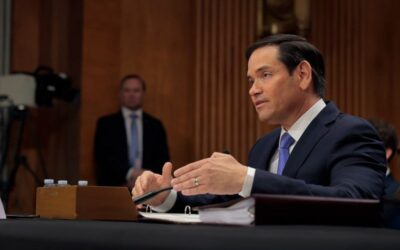
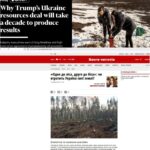

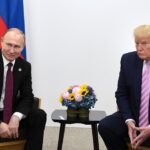














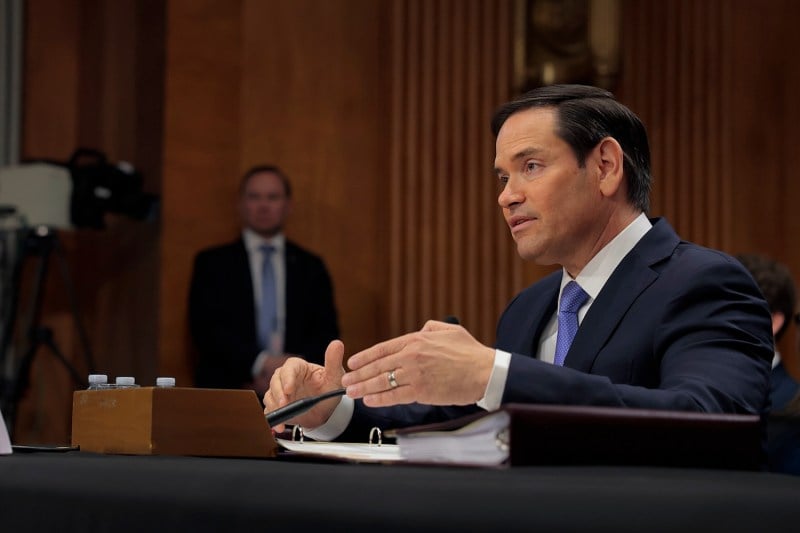

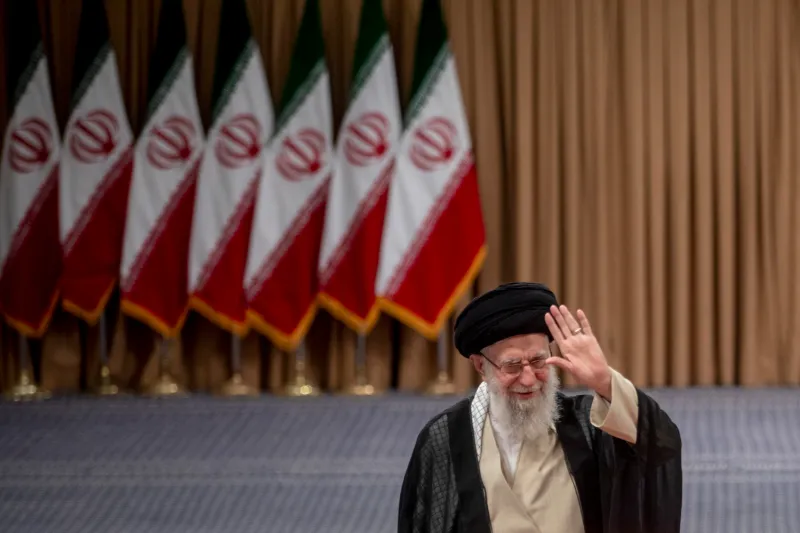
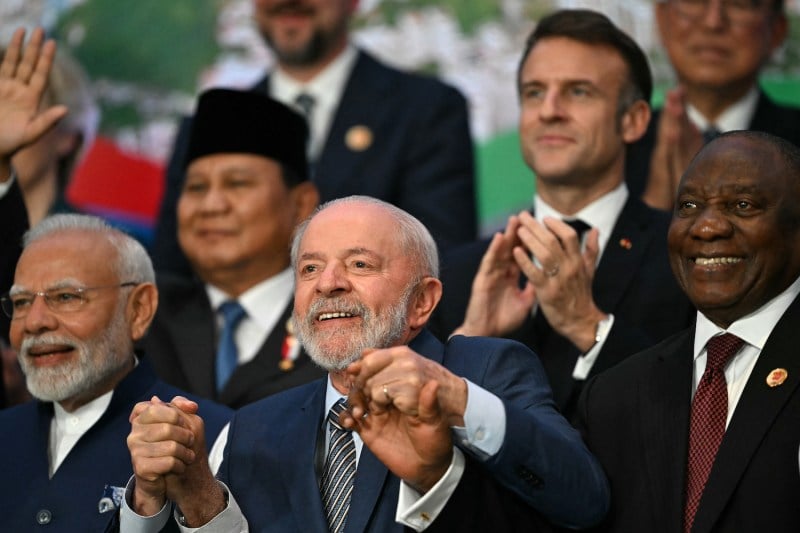
Join the Conversation
Commenting on this and other recent articles is just one benefit of a Foreign Policy subscription.
Already a subscriber?
.
Subscribe
Subscribe
View Comments
Join the Conversation
Join the conversation on this and other recent Foreign Policy articles when you subscribe now.
Subscribe
Subscribe
Not your account?
View Comments
Join the Conversation
Please follow our comment guidelines, stay on topic, and be civil, courteous, and respectful of others’ beliefs.
Change your username |
Log out
Change your username:
CANCEL
Confirm your username to get started.
The default username below has been generated using the first name and last initial on your FP subscriber account. Usernames may be updated at any time and must not contain inappropriate or offensive language.